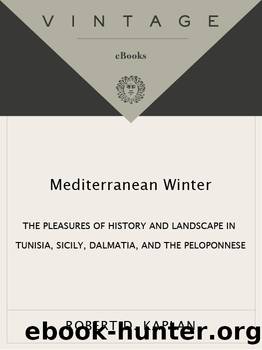Mediterranean Winter by Robert D. Kaplan

Author:Robert D. Kaplan [Kaplan, Robert D.]
Language: eng
Format: epub
ISBN: 978-1-58836-148-6
Publisher: Random House Publishing Group
Published: 2011-11-16T07:00:00+00:00
The first morning we had slept late and treated ourselves to cappuccinos and pastries in a bar before taking a short bus ride to the archaeological museum, located halfway between the town and the Valley of the Temples. The collection of Greek pottery is one of the world’s finest: case after case of massive, wide-necked kraters for stirring wine, and two-foot-tall, narrow-necked amphorae for storing it, as well as for holding grain and honey. Most of the pottery is from the mid-fifth century B.C., Greece’s golden age, which saw the democratic reforms of Pericles, the wars of the Greek city-states against Persia, and the Peloponnesian War. They showed epic scenes of soldiers leaving for battle, the intimacies of small dinner parties and symposia, mistresses being dressed by their servant girls, and musicians entertaining. There were scenes of startling sensuality—satyrs catching young women writhing in their chitons, men and women bathing, and Dionysian spectacles. The fixed expressions were always in profile, symbolic more than realistic. Because of the limitations of the style and the smallness of the surface area, like the Roman and Byzantine mosaics I had seen earlier in my journey, the scenes on these vases left much to the imagination. They were the opposite of television, which, because it shows everything, reveals nothing.
There was, too, a marble statue of a Greek warrior, sculpted sometime between 480 and 475 B.C., the period of the Greco-Persian wars. All that remains of this statue is a helmeted head and torso. The arms are missing and, except for part of a thigh, so are the legs. Yet the statue evokes all the horror of the Iliad. It captures the process of falling, mortally wounded, in a manner that takes one’s breath away. The torso, full of vigorous muscular mass, shows a contracted abdomen. The eyes seem set for one last effort before death. Nearby was a small white marble statue of Aphrodite, who seemed to be wringing her hair after a bath, even though she lacked an arm and was headless. When I returned to Agrigento in middle age, these statues were like the recovered spirits of brief, lost friendships: those with whom I had had a conversation in a hotel lobby or a railway station, whom I had known for only a few minutes or an hour, yet who had said something significant to me. These remnants of antiquity were retrievable in a way that other parts of my past were not.
We walked farther downhill into the plain where the temples lay. The Greeks of Sicily built on a grander scale than in Greece itself, much as early American structures were often larger and more spread out than their British cousins. The Temple of Zeus offered a panorama of devastation, with lizards darting over crumbled columns ennobled by lichen. Cacti punctured the soil in the spirit of naturalistic violence. A seven-meter-long limestone telemon lay on its back, its hands behind its head: these atlases had supported the roofs of the temples, like bodyguards around a vault.
Download
This site does not store any files on its server. We only index and link to content provided by other sites. Please contact the content providers to delete copyright contents if any and email us, we'll remove relevant links or contents immediately.
| Africa | Asia |
| Canadian | Europe |
| Holocaust | Latin America |
| Middle East | United States |
Fanny Burney by Claire Harman(25784)
Empire of the Sikhs by Patwant Singh(22172)
Out of India by Michael Foss(16312)
Leonardo da Vinci by Walter Isaacson(11901)
Small Great Things by Jodi Picoult(6093)
The Six Wives Of Henry VIII (WOMEN IN HISTORY) by Fraser Antonia(4790)
The Wind in My Hair by Masih Alinejad(4424)
The Lonely City by Olivia Laing(4120)
The Crown by Robert Lacey(4105)
A Higher Loyalty: Truth, Lies, and Leadership by James Comey(4032)
The Iron Duke by The Iron Duke(3639)
Millionaire: The Philanderer, Gambler, and Duelist Who Invented Modern Finance by Janet Gleeson(3568)
Sticky Fingers by Joe Hagan(3454)
Alive: The Story of the Andes Survivors by Piers Paul Read(3310)
Papillon (English) by Henri Charrière(3269)
Joan of Arc by Mary Gordon(3257)
Stalin by Stephen Kotkin(3084)
Aleister Crowley: The Biography by Tobias Churton(3019)
Ants Among Elephants by Sujatha Gidla(2924)
